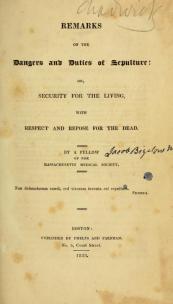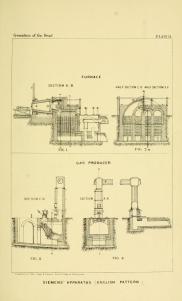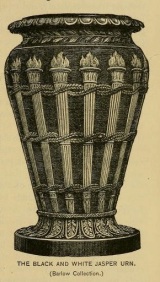In her insightful book, “This Republic of Suffering: Death and the American Civil War,” Drew Faust shows how the Civil War forever changed America’s experience of death. Never before had the country seen such a large fatality toll within such a short period of time: 750,000 people are believed to have died during the war, a number, according to Faust, “approximately equal to the total American fatalities in the Revolution, the War of 1812, the Mexican War, the Spanish-American War, World War I, World War II, and the Korean War combined.”[1] Such a scale of carnage introduced imminent challenges in handling the dead bodies of soldiers and civilians.
Yet the profound changes in Americans’ outlook on death persisted even in the aftermath of the war. Anxieties about infection and the desire to honor and commemorate the dead culminated in a debate about the practice of and location for disposing of corpses. Like in the Civil War, what was at stake in this debate was nothing less than the future of America.
 Although previously religious and cultural traditions governed funerary rites, a newly medicalized rhetoric marked the mid-nineteenth century debate. This discussion was part of a larger concern about “decaying matter” as a cause of disease that had occupied the thoughts of doctors and reformers since the beginning of the century. In 1823, John Gorham Coffin (yes, a fortuitously fitting name), a member of the Massachusetts Medical Society, expressed his concern about a scheme that would enable the deposition of corpses under St Paul’s Church in Boston. This, he warned, was a practice that had not been encouraged for sixty years, and for good reason. Decaying matter, he argued, was the source of “poisonous gases” that would sooner or later produce “sickness and death.” (19) Only the year before there had been a yellow fever epidemic in New York, which, Coffin insisted, surely had as its focus “the grave-yard of Trinity Church, saturated with dissolved semi-liquid human flesh, oozing from every pore, and the incumbent atmosphere filled with noxious effluvia, concurring with the air of the city […].” (20) His message to the city authorities was clear: “Whoever creates or tolerates a local source of atmospheric impurity, in the same proportion, hazards the introduction or spreading of an infectious endemic disease […].” (21)
Although previously religious and cultural traditions governed funerary rites, a newly medicalized rhetoric marked the mid-nineteenth century debate. This discussion was part of a larger concern about “decaying matter” as a cause of disease that had occupied the thoughts of doctors and reformers since the beginning of the century. In 1823, John Gorham Coffin (yes, a fortuitously fitting name), a member of the Massachusetts Medical Society, expressed his concern about a scheme that would enable the deposition of corpses under St Paul’s Church in Boston. This, he warned, was a practice that had not been encouraged for sixty years, and for good reason. Decaying matter, he argued, was the source of “poisonous gases” that would sooner or later produce “sickness and death.” (19) Only the year before there had been a yellow fever epidemic in New York, which, Coffin insisted, surely had as its focus “the grave-yard of Trinity Church, saturated with dissolved semi-liquid human flesh, oozing from every pore, and the incumbent atmosphere filled with noxious effluvia, concurring with the air of the city […].” (20) His message to the city authorities was clear: “Whoever creates or tolerates a local source of atmospheric impurity, in the same proportion, hazards the introduction or spreading of an infectious endemic disease […].” (21)
Coffin called for the disposal of corpses far outside of the city walls to avoid the spreading of sickness through putrefying flesh. While this concern persisted over the following decades, the proposed solution at the close of the Civil War was different. In the 1870s, cremation, hitherto unpractised in America, appeared as a new method for disposing of corpses. In his history of American cremation, Stephen Prothero dates the first cremation on American soil to that of Baron Joseph Henry Louis Charles De Palm in 1876.[2] This event was preceded and followed by a heated debate about the right way to dispose of the dead, which began in Europe and was continued predominantly among the white upper and middle classes of American society.[3] Yet although the cremation debate reflected a transatlantic transfer of ideas, cremation would also be constructed as a truly American form of burial.
In England, William Eassie, who had been appointed Secretary of the London Cremation Society Council in 1874, reviewed the arguments for  cremation in a pamphlet entitled “Cremation of the dead: its history and bearings upon public health.” According to this document, the revival of the practice of cremation had begun in Italy, where several publications about the practice had appeared since 1857, all of them written by doctors (68-73). It was an Italian physician, Dr. Brunetti, who exhibited a cremation furnace, as well as the ashes of a corpse burnt in its flames, at the 1873 Vienna Exposition (79). This exposition went a long way in promoting the idea of cremation on both sides of the Atlantic. There could be little doubt, Eassie began, that “the burning of the dead was originally resorted to on sanitary grounds, and as a means of protecting the living from corruption” (3). Yet Eassie also insisted that the practice was by no means a “heathen” one, as had been feared by many opponents of cremation, and, contrary to their claims, it was not incompatible with Christian doctrine. Opponents of cremation had been spreading rumors, he feared, claiming that the practice was to be made compulsory, or that cremation was really a means of “producing illuminating gas for general purposes” (2). All these rumors were false and mischievous, according to Eassie.
cremation in a pamphlet entitled “Cremation of the dead: its history and bearings upon public health.” According to this document, the revival of the practice of cremation had begun in Italy, where several publications about the practice had appeared since 1857, all of them written by doctors (68-73). It was an Italian physician, Dr. Brunetti, who exhibited a cremation furnace, as well as the ashes of a corpse burnt in its flames, at the 1873 Vienna Exposition (79). This exposition went a long way in promoting the idea of cremation on both sides of the Atlantic. There could be little doubt, Eassie began, that “the burning of the dead was originally resorted to on sanitary grounds, and as a means of protecting the living from corruption” (3). Yet Eassie also insisted that the practice was by no means a “heathen” one, as had been feared by many opponents of cremation, and, contrary to their claims, it was not incompatible with Christian doctrine. Opponents of cremation had been spreading rumors, he feared, claiming that the practice was to be made compulsory, or that cremation was really a means of “producing illuminating gas for general purposes” (2). All these rumors were false and mischievous, according to Eassie.
Yet it was true that cremation was preferable also from an economic point of view. Cremation furnaces, such as the one built by Siemens in Dresden, could “reduce a plurality of bodies” simultaneously, and overshadowed cemeteries through their “expeditious, cleanly, and economical results” (109-110). Eassie concluded with a call for activism on the part of his audience: everybody who wished to be cremated should put their wish in writing and place it in their writing desk. This peculiar 19th century ‘advance directive’ would ensure that the practice of cremation could “speedily prevail” (126).
It was to Eassie that Hugo Erichsen, founder of the Cremation Association of North America, dedicated hisplea for cremation in 1887. While the cause still required further advancement, Erichsen could at least assert that “the period of fierce and fanatic opposition to  cremation” had passed; a “calm consideration of the subject” was now possible. (Preface) Erichson echoed Eassie’s arguments that cremation was a more sanitary and economically viable form of burial. He also insisted that by now it had been sufficiently demonstrated that religious objections to cremation were absurd. The fear that burnt bodies would not be resurrected by God on Judgment Day was irrational, according to Erichsen; what kind of God would fail to save, for instance, “the soul of the brave fireman, who rushes courageously into a burning building to rescue his fellow beings, and has the misfortune to fall and perish in the place”? (192)
cremation” had passed; a “calm consideration of the subject” was now possible. (Preface) Erichson echoed Eassie’s arguments that cremation was a more sanitary and economically viable form of burial. He also insisted that by now it had been sufficiently demonstrated that religious objections to cremation were absurd. The fear that burnt bodies would not be resurrected by God on Judgment Day was irrational, according to Erichsen; what kind of God would fail to save, for instance, “the soul of the brave fireman, who rushes courageously into a burning building to rescue his fellow beings, and has the misfortune to fall and perish in the place”? (192)
Erichsen ended his monograph with an appeal to Americans’ patriotic spirit. He predicted that cremation would make “more progress in the United States than in any other country of the world.” His optimism stemmed from a firm belief in American progress and reform. “When we Americans once perceive the advantages and superiority of a reformation, we do not hesitate long to adopt it […]” (263-264). Cremation, as Stephen Prothero has pointed out, carried the hope of becoming a distinctly American practice, echoing the country’s values of innovation, efficiency, and equality. This was an “invented tradition” aimed at Americanizing Americans.”[4]
Such hope, however, would not be realized. Although cremation rates in the US have risen since the 1960s from 3.56% to 40.62% in 2010[5], cremation, according to Prothero, was still associated with “the odd and the offbeat” in the late 1990s. Today, the question of correct disposal of the dead has become a matter of choice. Bereaved families are customers who have to choose from a variety of burial services, ranging from traditional options such as interment and the now mainstream practice of cremation, to sea burials, burials in space, ‘green’ burials, and even mummification. To help with this often overwhelming multitude of choices, help groups, such as the Funeral Help Program, have recently sprung up, educating consumers about the options available to them, including considerations of cost.[6] While 19th century reformers heralded cremation as a symbol of progress, cremation today, along with other personalized funeral options, has become an expression of our increasing concern for individualism and informed consumption.
Further Reading:
Hotz, Mary Elizabeth. Literary Remains : Representation of Death and Burial in Victorian England. SUNY Series, Studies in the Long Nineteenth Century. Albany: State University of New York Press, 2009.
Prothero, Stephen. Purified by Fire: A History of Cremation in America. New Ed. University of California Press, 2002.
Rosen, Fred. Cremation in America. Amherst, N.Y.: Prometheus Books, 2004.
All primary sources mentioned have been contributed by the Francis A. Countway Library of Medicine and are available at the Internet Archive Database of the Medical Heritage Library.
[1] Drew Gilpin Faust, This Republic of Suffering : Death and the American Civil War, 1st ed. (New York: Alfred A. Knopf, 2008), xi.
[2] Drew Gilpin Faust, This Republic of Suffering : Death and the American Civil War, 1st ed. (New York: Alfred A. Knopf, 2008), xi.
[3] Ibid., 20–22.
[4] Ibid., 21–22.
[5] “National Funeral Directors Association – Statistics Report,’ http://www.nfda.org/media-center/statisticsreports.html, accessed January 17, 2013
[6] ‘Funeral Help Program,’ http://www.funeral-help.com/about.html, accessed January 15, 2013.
See the article in its original home and check out more Remedia content here.





